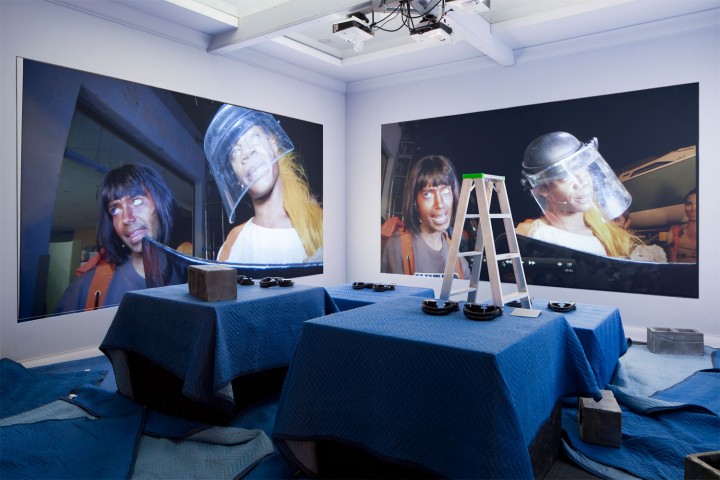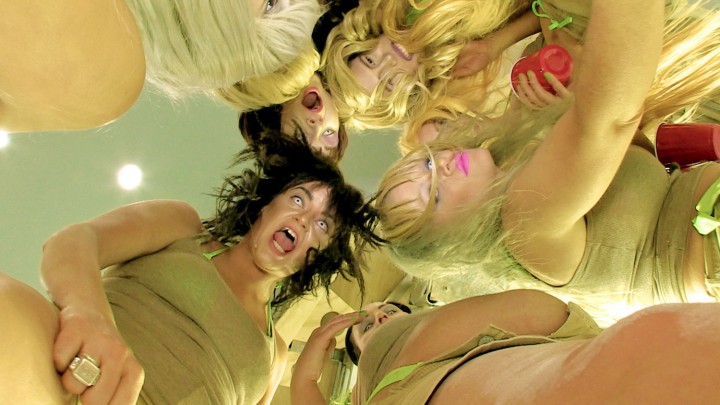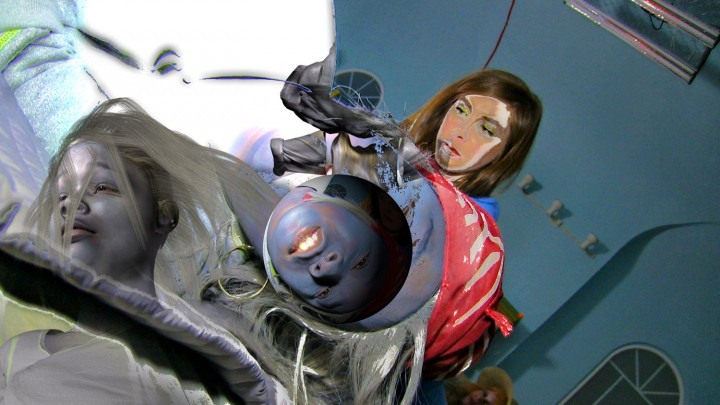
- Source: FLASH ART
- Author: Jarrett Gregory
- Date: OCTOBER 3, 2014
- Format: DIGITAL
Networks of Influence

Ryan Trecartin, Lizzie Fitch / Ryan Trecartin, Priority Innfield (Fence, Pole, Tilt, Villa, Way) (2013)
“We are really walking a fine line — in fact, our line might be so fine that we might be seen as failing.” — Director, Comma Boat, 2013
Across Ryan Trecartin’s relatively brief career, his name has become synonymous with a changing tide that hinges around technology — its use, dissemination and continuing impact. He first became the subject of critical attention when his senior thesis movie for RISD, A Family Finds Entertainment (2004), was included in the Whitney Biennial in 2006. The movie debuted on a small monitor next to the second-floor elevators, but despite its modest presentation it made a significant impact. On first glance it might have appeared banal or even obnoxious — a group of kids playing with a video camera at a fever pitch — but in Trojan Horse-fashion it unearthed more than could have been anticipated. Trecartin’s raw talent was striking, and his performance as the tortured and narcissistic musician Skippy — who locks himself in a bathroom and takes the present-day equivalent of “selfies” with a Polaroid camera before he slits his wrists in a joyful bloodbath — yielded several unforgettable scenes. The piece carried a genuine and undeniable sense of urgency; although it was distinctly rooted in the present moment, its chaotic murmurings threatened to prophesy the future of not only art but life as well.
It was ten years ago that the twenty-three year old student wrapped A Family Finds Entertainment, and since then a lot has changed and a lot has stayed the same. Working consistently with his partner-in-art Lizzie Fitch, Trecartin has become increasingly visible, featured predominantly in museum and institutional presentations, and was the subject of a major monographic exhibition, “Any Ever,” which traveled from MOCA Los Angeles to MoMA PS1 in New York in 2011. His most recent works debuted in 2013 at the 55th Venice Biennale in Massimiliano Gioni’s exhibition “The Encyclopedic Palace.” Continuing to address language and the construction of identity, the new movies significantly advance the ideas that Trecartin has been playing with since 2004, while stylistically they remain unmistakably his.
The 55th Venice Biennale featured four movies — Junior War, CENTER JENNY, Comma Boat, and Item Falls (all 2013) — projected within austere architectural settings conceived by the artists. The expanded, three-dimensional frames are reminiscent of vacant suburban environments — an empty bedroom, a pool house or bleachers — punctuated by portentous details: a chain-link fence or a pile of sleeping bags. Each space functions as a threshold: a Narniaesque wardrobe unleashing the visitor into Fitch and Trecartin’s universe. The viewing areas, termed “sculptural theaters” by the artists, mirror the vernacular of the on-screen sets and thus feel simultaneously anonymous and familiar, capturing an uneasy domesticity heightened by the cool glow of the projections. The movies themselves stand on their own as discrete works but relate to one another on a quasi-familial level. In an orchestrated symbiosis, they are strengthened when presented in tandem: together they generate an increasingly complete yet exponentially complex picture of a realm that will always be partially obfuscated.
Junior War, CENTER JENNY, Comma Boat, and Item Falls are joined by a tension between history and evolution, a theme that emerged while Trecartin was revisiting footage he shot of his peers during high school in Ohio in the late ’90s. The repercussions of Trecartin’s excavation were two-fold: he developed an increasingly clear understanding of the ways in which the human relationship to the camera has evolved, and he was motivated to pare down his ideas. Selecting from across thirty-two of his teenage tapes, he edited a fraction of the original footage to create Junior War. The 1999 source material captured a prior self as well as a bygone adolescent: before social media, the ubiquity of cell phones, and streaming video. Trecartin recognized the transformation on a behavioral and linguistic level, and the marked difference came to shape the plots, scripts and tenor of the accompanying movies that he filmed in 2013.

CENTER JENNY (video still) (2013).

Item Falls (video still) (2013).
Influence is integral to Trecartin’s practice; during his scriptwriting, he dips into the conversations, encounters and verbal snippets that ferment throughout his personal experience. Although he is an avid collaborator and relies on a consistent cross-pollination with Fitch, Trecartin’s writing process is entirely solitary. He is fascinated by rhetoric and how humans use words as a framing device; as such he is both obsessive when it comes to language and intentionally reckless, reveling equally in moments of exaction and chance. For these movies, Trecartin sought to challenge the very concept of a script. He imagined a narrative structure that was non-linear, fragmented and exploded — a script in 3-D.
Fitch and Trecartin devised a 360-degree filming experience that marries the visual composition of reality television with the ubiquity of surveillance to gather a surplus of audio and visual data that could be arranged into an endless number of narratives. The artists rendered their fantasy set in the open source 3-D modeling program SketchUp and hired professionals to fabricate it to human scale in a sound studio in Burbank. Inspired by a game show, the set describes a place for learning and recreation, while establishing a physical locus to engage standard entertainment relationships between host, talent, audience and crew. Although Trecartin plans the minutiae of his scripts and shoots, he counts on some ideas to emerge naturally — moments when an actor spontaneously inserts himself or herself into a scene, or the footage taken when he hands his camera off during a break. Fitch and Trecartin engineeredcharged spaces that would inspire unpredictability: a bed that spins like a lazy Susan, a working hot tub, a proscenium stage that can transition into a pit outfitted with trampolines. It is neitherinside nor outside, but a contained world. In a post-digital era, this is what a fallout shelter might look like: an auto-generated habitat—unique, customizable and sterile.
Filming takes place throughout the night; in the spring of 2013 the artists held eighteen shoots from approximately 8 pm until sunrise with three to five cameras active at a time, generating hundreds of hours of footage. Everyone on set was in costume, outfitted in athletic sweatshirts calling out their role: “Witness” for the director and film crew; “Audition” for the sorority-style competitors, and so on, thus eliminating any distinction between on and offstage. Each participant was miked and all of the input was fed through a PA system and auto-tuned in real time, which encouraged experimentation and allowed for more extraneous material to be usable. During filming the set was locked down with no exception. Fitch and Trecartin have worked to cocoon the adrenaline-fueled process; participating means temporarily letting go of the outside world, giving in to the hallucinatory process, and forgetting the time of day.
The physics governing Trecartin’s movie-universe are essential to any greater understanding of the works. In 1936 Walter Benjamin contended that watching a film alters the very structure of perception. When considered together, the movies Junior War, CENTER JENNY, Comma Boat, and Item Falls posit a related but more extreme theory of technology-induced evolution. Trecartin suggeststhat our capabilities are so advanced that they already differentiate us irreversibly from our ancestors. The starting point for the new movies thus follows a series of postulations: What if humans continued to evolve into an animated or automated state? What if the convergence of certain technological advances caused a second Big Bang?
CENTER JENNY describes a world in the distant future, post-human, when the predominant beings are studying their ancestors. Dinosaurs are believed to have evolved into chickens. In its historicization, the human era is drastically oversimplified and learned through a gaming system. CENTER JENNY is set in this game-cum-university, where an army of pupils all named “Jenny” enter with the classification Basic, and aim to proceed to levels 1, 2, and onward, in a caste system that is an evolution-based hierarchy of power and knowledge. It is a platform for competition and cruelty, modeled after the most ubiquitous social structures in place today.
At the helm is Sara Source, referred to by the girls as “the source,” who resides in Level Center and keeps company with her sidekick Monika Nark, played by sisters Renee and Aubrey Plaza. Sara is privileged and wealthy, and owns a system to automate her homework so she can go on vacation with her parents. The protagonist of the film is Basic Jenny, played by Rachel Lord, the newest entrant into the university system and thus the most inferior. Over the course of the movie, viewers watch her lose and gain a meager allotment of agency. It concludes around Trecartin’s darkest and most visually charged sequence to date, as Lord’s character is splayed out and voluntarily hazed, covered in Sharpie markings by a swarm of girls while her professor lectures in her ear.

Installation view, Punta della Dogana, Venice (2013). Courtesy of the Artists; New Galerie, Paris; and Regen Projects, Los Angeles.
Item Falls was the only movie that was filmed at Fitch and Trecartin’s rambling home in the Los Angeles neighborhood of Los Feliz. It is awash with animations designed by longtime collaborator and fellow RISD graduate Rhett LaRue — from spinning architectural models to hovering baseball caps and red Solo cups that splinter into cascades of confetti. The characters brag about their free will and the chickens they have bred and trained for stunts. As they speak, the actors devolve into 2-D animations, their faces periodically emerging as cartoonish drawings of black lines and color planes. At other junctures, 3-D animations rendered to look like the actors perform basic functions such as walking or sleeping. In Item Falls, all characters are nameless; everyone’s identity and social standing is up for grabs based on their performances at auditions and their ability to evolve across different animation stages.
Throughout the filming process of CENTER JENNY and Item Falls, Trecartin remained in character as a hostile and unstable film director. The footage of Trecartin at work — a portrait of the artist in his studio, of sorts — is the material that makes up the three-channel movie Comma Boat. Most often, Trecartin takes a dictatorial approach, feeding the actors paragraphs to recite to the camera while he becomes increasingly frustrated, or using expletives to motivate large groups of actors into formation. At other points he sits on the sidelines, chattering in a saccharine-calm pitch about words, alphabets and the history of the world, while writing a script for a potential character that he himself would play. Entirely non-narrative, the movie adopts a behind-the-scenes, process-based structure of reaction and response.
In 1957 Marcel Duchamp wrote “The Creative Act,” a short text in which he argued that the artist is partially a conduit — that during the process of making art there is no way to be fully self-conscious. Trecartin is an exemplar of this theory; trusting in what is unintentionally expressed, his subconscious acts as an essential source for the ideas and associations that come to life in his work. In his blinder-style form of making, Trecartin powers forward, relying on the world around him to oversaturate his mind and vision, creating a multiplicity of untraceable influences that he absorbs into his practice. Aspects of his work mash up the spectacle and overload aesthetic of Jason Rhodes, Francis Picabia’s use of machine forms to portray human characteristics in his portraits mécaniques, the vivid object-driven tableaux of Isa Genzken, or the impetus of cubists to carve up their subjects in order to show multiple perspectives simultaneously. Stylistic references, though unintentional, are essential for audiences to take steps toward contextualizing the work.
Although Trecartin binges on aftereffects, composes music using royalty-free ringtones, and films the painted faces of his peers as they navigate a web of incomprehensible story fragments, his experimentations in structure and form reveal his ambition for a precision of expression. In the ’30s, László Moholy-Nagy predicted that images would become an essential form of communication when he asserted that the future illiterate would be those people unable to use a camera. Looking forward, editing is on its way to becoming a universal language, while tools like graphics and animation become the diction and lexicon allowing for its communication. Trecartin mines this vocabulary, forcefully evolving editing into something that can stand on its own as a form of expression. By articulating from within the specific nonsense and excess that characterizes our culture today, Trecartin addresses the universal ambiguity at the core of human experience. Far from creating commentary on, or parody of, media and its various equipment, he uses technology as a language to inquire into timeless questions about the nature of existence. While digital trappings may seem inextricable from his project, the artist is confident that if video did not exist he would be pursuing his explorations through the mediums of poetry or dance.
Trecartin has identified a pattern in his work: one movie lays out a new set of principles that the subsequent group comes to actualize. I-BE AREA (2007), for example, presented the structures and theories that Trill-ogy Comp (2009) and Re’Search Wait’S (2009–10) completed. With this most recent project, Trecartin is once again in the first phase, building and describing ideas that a future suite of movies will internalize. As Trecartin further stretches the boundaries of the medium, he will continue to challenge the viewer’s ability to evolve alongside it.

